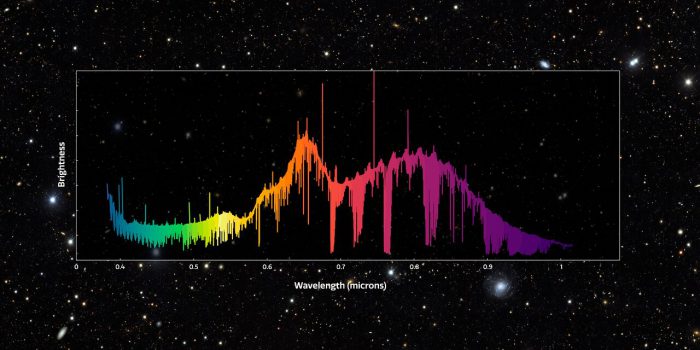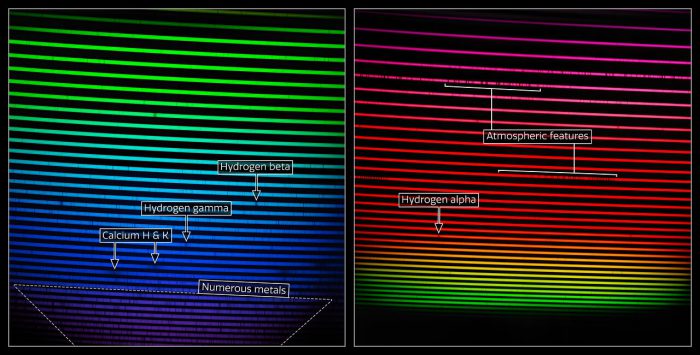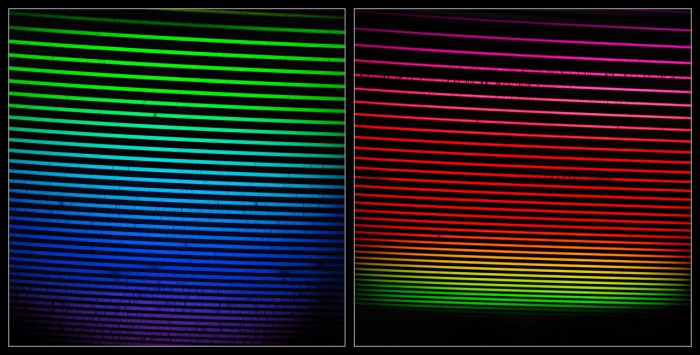These days, everyone is talking about the images being taken by the brand new James Webb Space Telescope. Including us just yesterday!
It is easy to understand why. It is the most powerful space telescope ever launched, letting us see more distantly—and more clearly—into the universe than ever before.
But there are many ways to 'see' into space. A machine like the James Webb can show us what a distant star looks like. But what if you want to see what it is made of? How it moves? Even how old it is?
For that work, you want a spectrograph. This is a machine that sees and analyzes the light emitted by a star in amazing detail.
Recently, a brand new deep space spectrograph, the Gemini High-resolution Optical SpecTrograph (GHOST), revealed its first-ever images. They are of a star called HD222925. You can see them at the top of this post.
These images are stunning, even if they are a bit difficult to understand at first. Let's decode them together!
What is a spectrograph seeing?

Another way of viewing the spectrum that you see at the top of the post. This version helps astronomers see how bright each part of the star's spectrum is. (International Gemini Observatory/NOIRLab/NSF/AURA/GHOST Consortium)
A spectrograph captures the light that is emitted, or sent out, by a star, and turns it into a range of colours. That range is called a spectrum. (One of the best examples that we have of a spectrum is a rainbow, which is a spectrum of visible light waves.)
Every star emits light differently. So every star's spectrum is different, too. These differences are based on details like what the star is made of, how large it is, even the way that it is moving through space.
If you take a 'picture' of that spectrum of light, you can see these hidden details. It's a little like reading a star's fingerprint, or seeing an X-ray image of its insides.
Elementary differences

A 'normal' image of the star HD 222925. You can see how the spectrograph reveals a lot of hidden details that we can't see by just looking at a photo. (The STScI Digitized Sky Survey)
One of the most important details you can see with a spectrograph are the elements within a star. This is because certain elements absorb and re-emit light differently from one another.
A young star, which is full of hydrogen and helium, will emit a different looking spectrum than an older star that is developing 'heavier' elements like carbon and oxygen, or even metals like aluminum and iron. (These are called 'heavier' because these elements have more particles in their atoms.)
By looking at a star's spectrum, astronomers can tell what elements are in that star. How? The different elements reveal their presence by leaving behind what are called 'absorption lines' on the spectrum. These appear as little black notches across the 'rainbow'. Every element will leave behind a notch in a different spot.
A 'chemically complex star'

This labelled spectrum of the star HD 222925 is showing you what elements scientists can see. Can you pick out the black absorption lines the scientists are looking for? They look like tiny smudges! (International Gemini Observatory/NOIRLab/NSF/AURA/GHOST Consortium)
Now that we know a little bit about what scientists are looking for, let's go back to the spectrograph images of HD 222925. Thankfully, some helpful scientists at the NOIRLab have labelled them for us! (NOIRLab is an American astronomy researcher that will use GHOST a lot from now on.)
Here, we can see that this star is an older one. How? The labelled image of the spectrum shows that it is full of 'numerous metals' (bottom left). These elements only begin to appear later in a star's life.
And that is only the start of the kinds of information that experts can see with a spectrograph. Amazing!
 What details about the star HD 222925 are hidden in these images? Let's find out! (International Gemini Observatory/NOIRLab/NSF/AURA/GHOST Consortium)
What details about the star HD 222925 are hidden in these images? Let's find out! (International Gemini Observatory/NOIRLab/NSF/AURA/GHOST Consortium)









